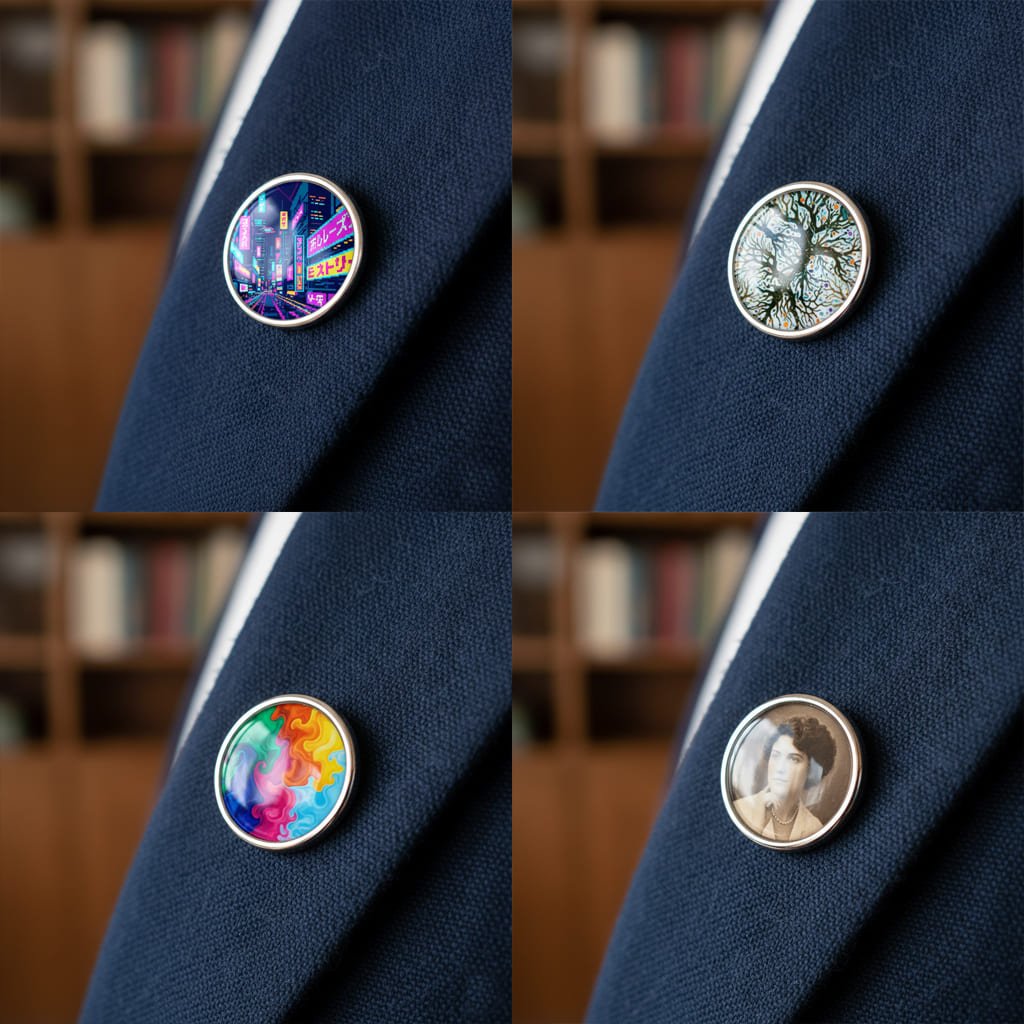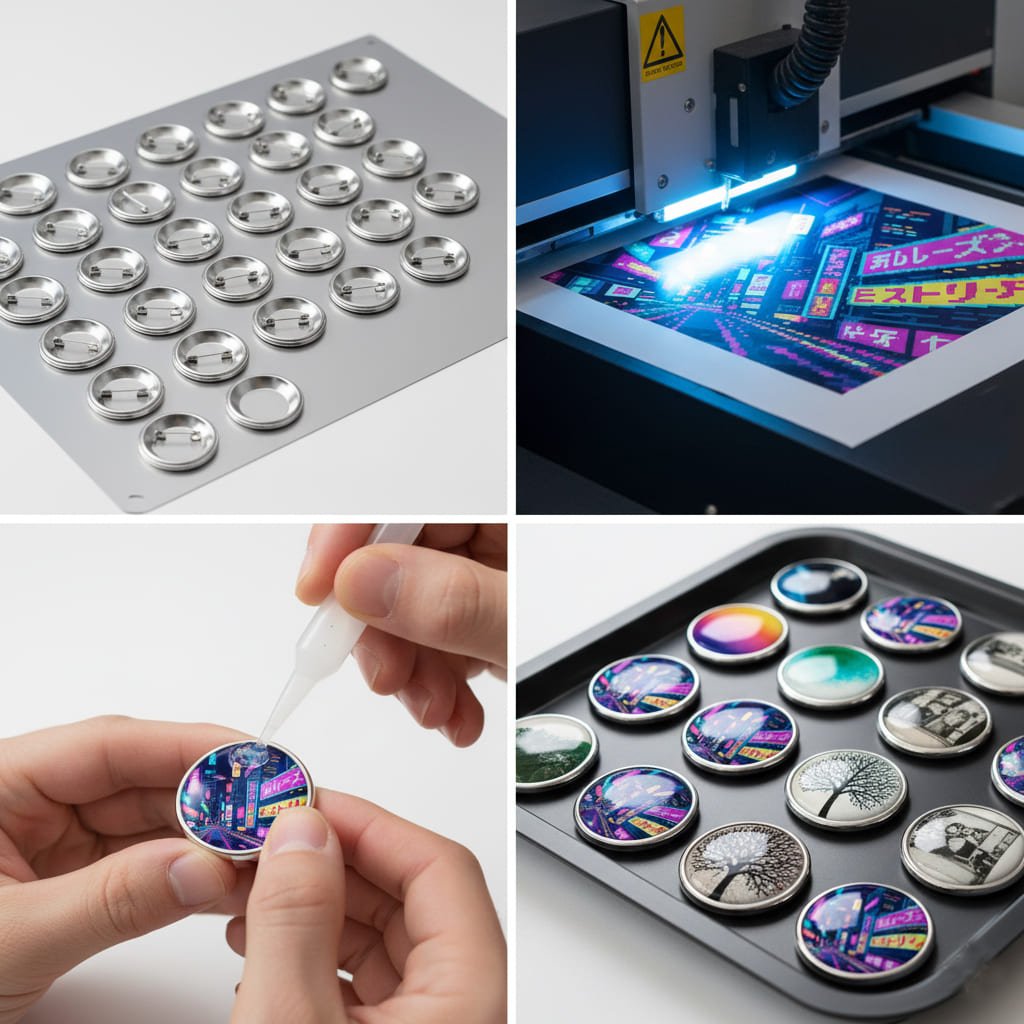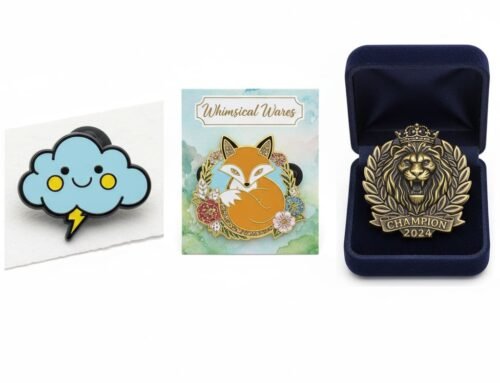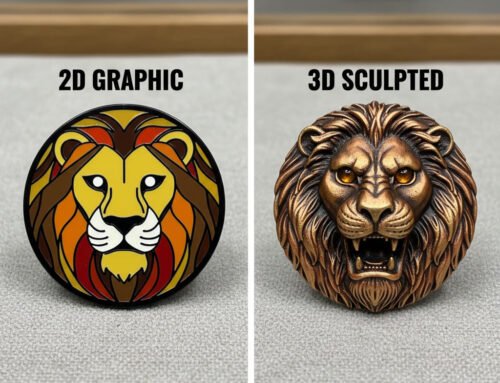You have a beautiful, complex design—a photograph of a beloved pet, a detailed painting with subtle gradients, or intricate artwork with dozens of colors. You send it to a pin manufacturer, only to be told it can’t be made as a traditional enamel pin. This is a common and frustrating dead-end for many creators. But what if it’s not a dead-end at all? What if there’s a different technology designed specifically for this challenge?
Welcome to the world of printed pins. This is your definitive guide to understanding this powerful and versatile pin style. We will explore exactly what printed pins are, the specific types of “impossible” designs they bring to life, how they are made, and how they compare to traditional enamel. By the end of this guide, you will be able to confidently determine if a printed pin is the perfect solution for your project and avoid the common pitfalls we discuss in our guide to ordering pins from overseas.
Sadržaj
What is a Printed Pin in the Simplest Terms?
A printed pin is a custom pin where the design is not filled with enamel paint. Instead, the artwork is printed directly onto a metal base using high-resolution printing technology. The printed image is then almost always sealed under a protective, clear epoxy dome. This results in a smooth, glossy, and highly detailed final product that can faithfully reproduce any digital image.
Core Concept Table: Printed vs. Enamel Pins
Key Differences at a Glance
| Feature | Otisnuta igla | Traditional Enamel Pin (Hard & Soft) |
|---|---|---|
| Color Style | Unlimited, Photographic, Gradients (CMYK). | Solid, Flat Colors (Pantone/PMS). |
| Level of Detail | Extremely High. Can reproduce photos and fine text perfectly. | Limited by the thickness of the metal die lines. |
| Texture | Smooth & Glossy (due to the protective epoxy dome). | Varies: Textured (Soft Enamel) or perfectly flat (Hard Enamel). |
| Key Feature | Perfect, pixel-for-pixel replication of complex digital images. | Bold, vibrant blocks of color physically separated by metal. |
| When to Use | Photographs, gradients, artwork with 20+ colors. | Logos, graphic illustrations, and designs that rely on solid colors. |
The Definitive Checklist: 5 Times a Printed Pin is Your Best (or Only) Option
This is the core of your decision. Traditional enamel pins are fantastic, but they have physical limitations. If your design falls into any of the following five categories, a printed pin is not just an alternative; it’s the superior solution.

Scenario 1: Your Design is a Photograph
This is the most common reason to choose a printed pin. A photograph is composed of millions of tiny pixels, each with a slightly different color, creating subtle shifts in tone and light. The enamel process, which requires solid blocks of color separated by metal lines, simply cannot replicate this.
The printed pin solution uses high-resolution digital printers that can perfectly reproduce those millions of pixels onto the metal surface, creating a crisp, clear, and faithful reproduction of your original photo. For a complete look at all pin styles, visit our Vrhunski vodič za prilagođene igle za revere.
- Common Use Cases: Memorial pins featuring a person’s portrait, political campaign pins, pins for showing off a beloved pet, real estate pins with a picture of a house, or promotional pins featuring a new product.
Scenario 2: Your Design Contains Color Gradients and Shading
In a traditional enamel pin, the metal “die lines” act as physical walls. This makes it impossible to smoothly blend one color into another. If your logo or artwork features gradients—like a sunset fading from orange to purple, or realistic 3D shading on an object—enamel is not an option.
The CMYK printing process, however, is specifically designed to create these effects. Just like a high-quality magazine print, it uses tiny dots of color to create the illusion of a smooth, seamless transition from one shade to another. This is something that even the most premium hard enamel pin cannot do.
Scenario 3: Your Design Has Extremely Fine, Non-Enclosed Details
This is a more technical, expert-level point. As we’ve established, enamel colors must be in a “pool” completely surrounded by a metal wall. But what if you have a tiny detail, like a sprinkle on a donut, that you want to be a different color but don’t want a metal line around it? Or what if you have very small, delicate text that would be filled in by a metal outline?
Since the design on a printed pin is printed directly onto the surface, no metal walls are needed between colors. This allows for tiny, free-floating details and text to be rendered perfectly, without the need for a containing metal line. This is a critical point we cover in our 10 Critical Design Tips for Pins.
Scenario 4: Your Design Has a Massive Number of Colors (20+)
While enamel pins can be made with many colors, each color is typically filled by hand and often requires a separate baking cycle. A design with 20, 30, or 50+ distinct colors becomes incredibly labor-intensive and expensive to produce as an enamel pin. The cost would be prohibitive.
A CMYK printer, on the other hand, can produce a million colors just as easily as it can produce four. With printed pins, the number of colors in your design has virtually no impact on the cost. This makes it the most economical choice for reproducing intricate illustrations, stained-glass window designs, or complex flags and seals.
Scenario 5: You Need a Perfect, Pixel-for-Pixel Replication of Digital Art
The process of turning digital art into a metal mold and solid enamel colors always involves some degree of simplification and interpretation. The final enamel pin is a beautiful representation of the art, but it is not a 1:1, pixel-perfect copy.
If your goal is an exact, faithful reproduction of your original digital artwork—including every subtle texture, digital brush stroke, and color variation—offset printing is the only way to achieve it. It respects the integrity of the original art without compromise.
Inside the Factory: The Technology Behind Printed Pins
Understanding the manufacturing process helps you appreciate the capabilities of this versatile pin style. There are two main methods for printing pins, each with its own strengths.
Offset Printing vs. UV Printing: What’s the Difference?
- Offset Printing (The Traditional Method): This is the same technology used to print high-quality magazines and brochures. It uses tiny dots of Cyan, Magenta, Yellow, and Black (CMYK) ink transferred from plates to the metal surface to create a full-color image. It is the best method for achieving photographic realism and smooth gradients.
- UV Printing (The Modern Method): This process uses a sophisticated inkjet method to apply ink directly to the metal surface. Immediately after the ink is applied, a high-intensity ultraviolet (UV) light passes over it, instantly curing and hardening the ink. This results in incredibly crisp, sharp, and vibrant designs.
The Step-by-Step UV Printing Process
- Creating the Blank: First, a sheet of metal (stainless steel or brass) is stamped and cut into the custom shape of your pin.
- Priming (Optional): To make the colors even more vibrant, a white primer coat may be sprayed onto the metal surface first.
- Printing: Your high-resolution digital file is sent to the UV printer, which applies the ink directly onto the metal blank with incredible precision.
- UV Curing: The UV light instantly cures the ink, making it hard and durable.
- The Epoxy Dome: This is a crucial step. A crystal-clear, protective layer of epoxy resin is applied over the entire printed surface.
- Final Curing & Assembly: The epoxy is cured, the pin backing is attached, and the pin goes through final quality control.

A Designer’s Guide to Printed Pins
The rules for designing a great printed pin are different from those for an enamel pin. By preparing your artwork correctly, you can ensure a stunning final product.
Resolution is King: The Importance of 300 DPI
Unlike enamel pins, which require a vector file, printed pins need a high-resolution raster file (like a JPG or PNG). The most important specification is the resolution, measured in DPI (Dots Per Inch). For a sharp, crisp print, your file must be at least 300 DPI at the final print size. A low-resolution file (like an image saved from a website) will result in a blurry, pixelated pin.
The Correct Color Mode: Designing in CMYK
For the most accurate color results, your artwork file should be set up in CMYK color mode. This most closely represents how the colors will look when they are physically printed with ink. If you provide an RGB file, the colors may shift slightly during the automatic conversion to CMYK for printing.
Printed Pins vs. Other Styles: The Strategic Comparison
How do printed pins stack up against the competition? This table will help you make a final, strategic decision based on the specific needs of your project.
The Master Comparison Table
Die-Struck vs. Enamel vs. Printed Pins
| Feature | Die-Struck Pin | Soft Enamel Pin | Hard Enamel Pin | Otisnuta igla |
|---|---|---|---|---|
| Use of Color | None (100% Metal) | Yes, vibrant solid colors | Yes, premium solid colors | Yes, full photographic color |
| Primary Aesthetic | Classic, Elegant, Formal | Textured, Vibrant, Playful | Smooth, Polished, Jewelry-like | Photographic, Detailed |
| Key Feature | Metal Texture & Relief | Raised Metal Lines | Smooth, Flat Surface | Full-Color Gradients |
| Izdržljivost | Extremely High | Good | Extremely High | Good (with epoxy) |
| Relative Cost | $-$$ (Cost-effective) | $ (Most affordable) | $$$ (Premium) | $$ (Mid-range) |
| Best for Detail | Good for textural detail. | Excellent for fine line detail. | Good, but polishing can soften lines. | Best for photographic detail. |
Practicalities, Cost, and Expert-Level Hybrids
Let’s cover the final details you need to know before placing an order.
The Cost Structure of Printed Pins
The pricing for printed pins is still primarily based on size and quantity. However, there is one major advantage: unlike enamel pins, the number of colors in your design has no impact on the price. A pin with 100 colors costs the same as a pin with 4. This makes it incredibly cost-effective for complex art. Be aware that some manufacturers may charge a one-time setup fee for the printing process. For a full pricing overview, please see our Potpuna raščlamba prilagođenih cijena pinova.
The “Best of Both Worlds”: The Hybrid Pin (Enamel + Printing)
For a truly premium and unique product, it’s possible to combine technologies. We can create a high-quality hard enamel pin and then use UV printing to add very fine, detailed text or logos on top of the smooth enamel surface. This combines the weight and perceived value of hard enamel with the fine detail of printing, creating a stunning final product.
Conclusion: Your Solution for Limitless Creativity
Printed pins are not a “lesser” ili “cheaper” alternative to enamel pins. They are a powerful, specialized tool in the custom merchandise world, specifically designed to bring your most complex, detailed, and photographic visions to life with perfect accuracy. The final step to a professional product is presentation, a topic we cover in our Vodič za kupce za prilagođeno pakiranje igle.
By understanding when to choose this versatile style, you are no longer limited by the constraints of traditional manufacturing. You can confidently create a pin that is a true, faithful reproduction of your art, a capability that empowers brands, artists, and organizations alike.
Have a Complex Design? Let’s Make It Happen.
If you’ve been told your design is “too complex” for a pin, we have the solution. Send us your artwork—whether it’s a photograph, a detailed illustration, or a logo with gradients—and our team will provide a free digital proof showing you exactly how it will look as a stunning, high-resolution printed pin.




